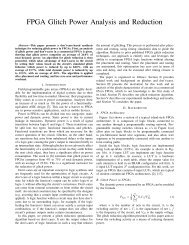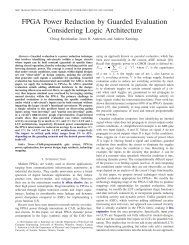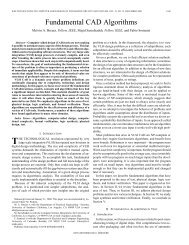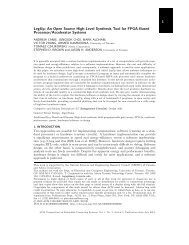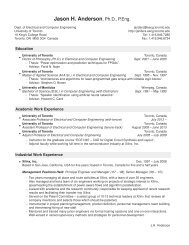Power Optimization and Prediction Techniques for FPGAs - Jason H ...
Power Optimization and Prediction Techniques for FPGAs - Jason H ...
Power Optimization and Prediction Techniques for FPGAs - Jason H ...
You also want an ePaper? Increase the reach of your titles
YUMPU automatically turns print PDFs into web optimized ePapers that Google loves.
2.5 FPGA <strong>Power</strong> <strong>Optimization</strong>2.5.3 Dynamic <strong>Power</strong> <strong>Optimization</strong> (CAD <strong>Techniques</strong>)Figure 2.16 shows the typical FPGA CAD flow, comprised of HDL synthesis, technology mapping,clustering, placement, <strong>and</strong> routing. In the HDL synthesis step, an input design is synthesizedfrom a text description, typically VHDL or Verilog, into a circuit netlist, composed ofgeneric primitive elements from a target library. The library may consist of st<strong>and</strong>ard logic gates(<strong>for</strong> example, AND, OR, NOT) or it may contain FPGA-specific elements (<strong>for</strong> example, LUTs).In technology mapping, the synthesized circuit is trans<strong>for</strong>med into elements that resemble thoseavailable in the target FPGA device, primarily LUTs <strong>and</strong> flip-flops. As mentioned above, logicblocks in commercial <strong>FPGAs</strong> contain multiple LUTs, flip-flops, as well as arithmetic <strong>and</strong> othercircuitry. A clustering or packing step is invoked after technology mapping to group LUTs <strong>and</strong>flip-flops into clusters corresponding to the logic blocks of the target FPGA. Placement assignsthe logic blocks in the design to logic block sites on the FPGA. Routing <strong>for</strong>ms the desiredconnections between logic blocks. Finally, the routed design is translated into a configurationbitstream <strong>for</strong> programming the device.The potential <strong>for</strong> power optimization has been studied at each stage of the flow in Figure2.16. We briefly describe some of the published approaches below.Front-end SynthesisA power-aware HDL synthesis system <strong>for</strong> <strong>FPGAs</strong> was recently described in [Chen 03]. The systemleverages three observations that are unique to <strong>FPGAs</strong>: 1) datapath circuits often containlarge multiplexers, <strong>and</strong> implementing multiplexers in <strong>FPGAs</strong> imposes a substantial dem<strong>and</strong> onLUTs <strong>and</strong> interconnect; 2) <strong>FPGAs</strong> contain a large number of registers – typically one registerper LUT; 3) interconnect accounts <strong>for</strong> the bulk of FPGA power consumption. The proposedsynthesis algorithm aims to reduce interconnect usage by trading-off the number of multiplexerports with register count. Through a 9% increase in register count, the number of multiplexerports is reduced by 23%, significantly reducing dem<strong>and</strong> on interconnect. Considerablepower reductions of more than 30% are reported, in comparison with a commercial synthesis33



